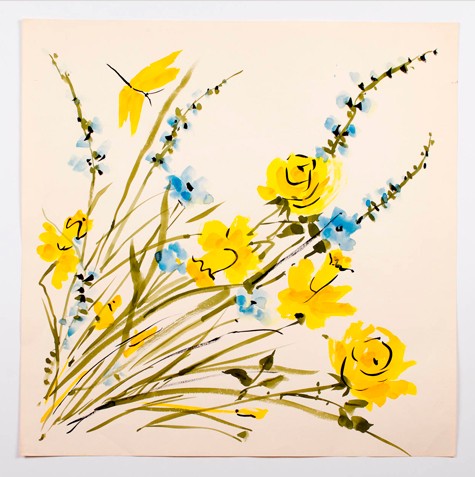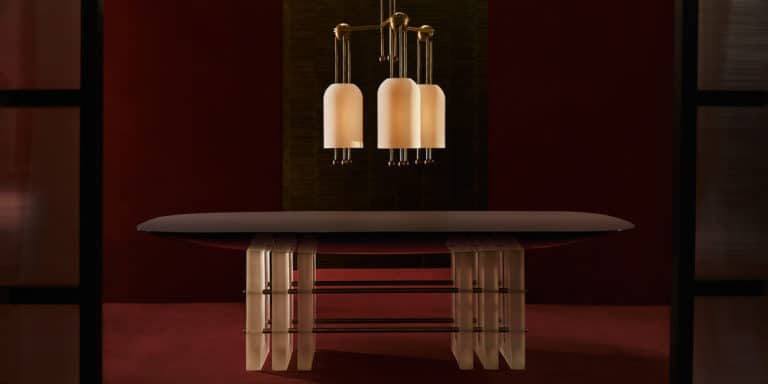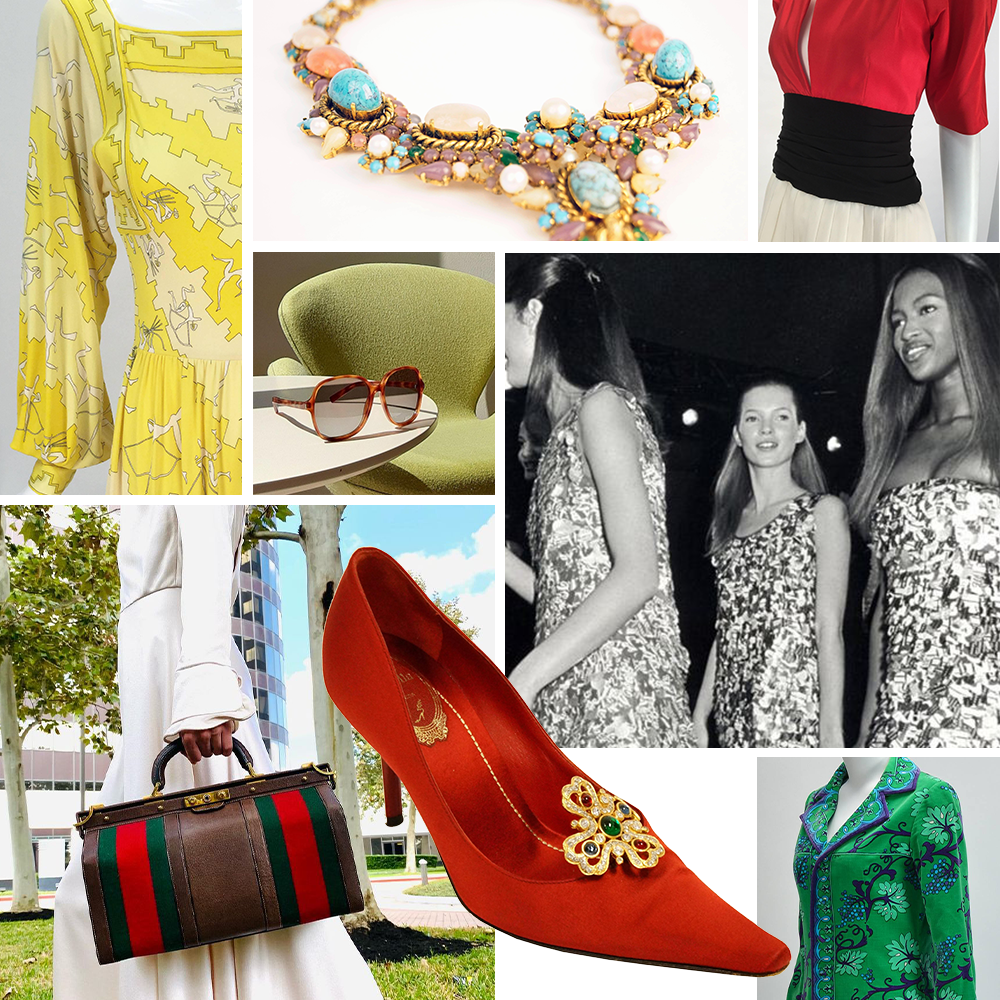
February 16, 2015Designer and artist Vera Neumann drew much of her inspiration from nature, as is evidenced by pieces such as Poppies, 1983, from her “Florals” series. Top: Alexander Gray Associates, who are now offering a large selection of Neumann’s original paintings for purchase, held an exhibition of her work in its New York gallery last summer. All photos courtesy of Alexander Gray Associates
There was a time when the name “Vera,” written in a flowing cursive script, was evocative of a certain earthy, liberated and joyful mid-century design sensibility. Particularly in the 1960s and ’70s, Vera Neumann was a household name (or, at least, “Vera” was) thanks to that signature, which appeared on her brilliant and graphical distillations of the world around us and were, in turn, printed on napkins and tunics, wallpaper and, most ubiquitous of all, scarves. The small ladybug icon that often appeared in her designs was a symbol of artful taste, and her affection for warm colors is one of the reasons that we remember the era with an orange tint.
Neumann (1907-1993), neé Salaff, was a Stamford, Connecticut, native who attended New York’s Cooper Union alongside the painter Lee Krasner. Then she enrolled in the city’s Traphagen School of Design, which launched her on a fashion career that included stints as a fashion illustrator and textile designer on Seventh Avenue. She met and married the Viennese advertising executive George Neumann, and they started their company just as World War II was ending, putting their first prints on surplus army silk. The company eventually rocketed her to mogul status, doing more than $100 million in business in some years. A close friend of Alexander Calder, she commissioned the architect Marcel Breuer to design her Hudson Valley house and to oversee her New York retail stores. Simply put, Vera had innate style.

Neumann, seen here in her Ossining, New York studio in the 1974, began a massive commercial venture when she and her husband started a company selling scarves, textiles and other goods featuring her designs; at its peak the company’s annual sales surpassed $100 million.
Though Neumann had artisans expanding on her ideas for the huge range of products the company made, everything started with a sketch or other artwork by her own hand. And now, the New York gallery Alexander Gray Associates is for the first time offering her original works to art collectors in a comprehensive and coordinated way.
“What a fascinating figure, and what a proto-feminist story,” says Gray, who, even before getting involved with her artworks, was an obsessive collector of Vera napkins and placemats. Gray admires that she was a “branding pioneer” as well as a talented draftswoman and colorist.
“It’s one of the first brands where the name was right on the item,” says Gray. “Without her, there’s no Martha Stewart and no Tory Burch.” A future icon, Perry Ellis, got his start designing sportswear for Vera.
But unlike those more familiar names, Neumann was marketed with a discreet mystique. “The idea,” Gray continues, “was that Vera went out into the world with her sketchbook and brought back these designs” — which was absolutely true. Eric Shiner, the director of the Warhol Museum, praises her “kaleidoscopic” color palette and overall aesthetic. “From a formal perspective, her hand was tight and controlled,” he says, “yet still allowed for airy and playful designs that audiences immediately responded to, thanks to their happy subjects and warm tones.”
The fashion marketer and entrepreneur Susan Seid helped rescue the Vera brand from obscurity — she was prescient enough to see that the originals were worth something and bought them when she purchased The Vera Company in 2005. Though Vera had stayed involved until her death, the company had been sold to a larger entity, and the brand had been languishing. Though Seid recently sold the business, she’s now focused on Neumann’s role as an aesthetic game-changer. She retained all of Vera’s artworks, and has partnered with Gray to sell them.
“From a formal perspective, her hand was tight and controlled, yet still allowed for airy and playful designs that audiences immediately responded to, thanks to their happy subjects and warm tones.”

Vera studied fine art at the Cooper Union alongside the painter Lee Krasner before detouring into a career in fashion and home accessories. Her artwork, nonetheless, found its way into the collections of MoMA and the Met, among other museums. Above: Untitled, ca. 1978, from the “Florals” series.
“Vera changed the landscape of how people viewed art, in terms of taking it off the walls and surrounding themselves with it,” says Seid, who notes that Neumann’s work is in the collections of New York’s Metropolitan Museum of Art and MoMA.
The Smithsonian Institution gave her a whole show in 1972: “A Salute to Vera, the Renaissance Woman.” Today, the newly revamped Cooper-Hewitt, Smithsonian Design Museum, has several of Neumann’s botanical-pattern textiles and wallpapers in its collection, including some from her long collaboration with F. Schumacher & Co.
Seid and Gray met through mutual friends, and Gray got emotional when he learned of Seid’s connection to Neumann, long a personal favorite. “Alex was tearing up,” Seid recalls. “I can’t imagine partnering with anyone else. He gets it.”

The exhibition of Neumann’s art at Alexander Gray Associates last summer included works in paint, watercolor, collage and gouache. The gallery is planning another show of her work for later this year.
Last summer, Gray had an exhibition of Neumann’s varied artistic output — she worked in paint, watercolor, collage and gouache, although watercolors represent a sizable portion of what Gray offers, and may be her best medium — and he’s planning another one for later this year. Generally the pieces sell for between $2,500 and $10,000.
Nature served as her essential inspiration. The fiery orange and red of the watercolor Oriental Poppy, 1974, demonstrates her ability to capture flora; a vibrantly blue-hued butterfly in the same medium (undated and untitled) shows her appreciation of fauna.
Helping collectors rediscover Neumann’s work in a fine art context is Gray’s mission. “This dovetails with what we do: looking at artists who have had a historical impact on other artists, curators and scholars but have been missed by the market because of race, gender or geography,” says Gray. “We’re known for working with older, overlooked artists who should be celebrated, and putting them in the present tense.”
Part of Neumann’s absence from the art market is her own doing. “She wanted to sell scarves, not paintings,” Gray points out. But he still finds it poignant that she’s not better known. “Artist sometimes get lost,” he says. “If she had been born ten years later, it would have been a different story.”
Now, some four decades on, if Gray and Seid have their way, a new chapter of that story is just beginning.
Shop Vera Neumann on 1stdibs









